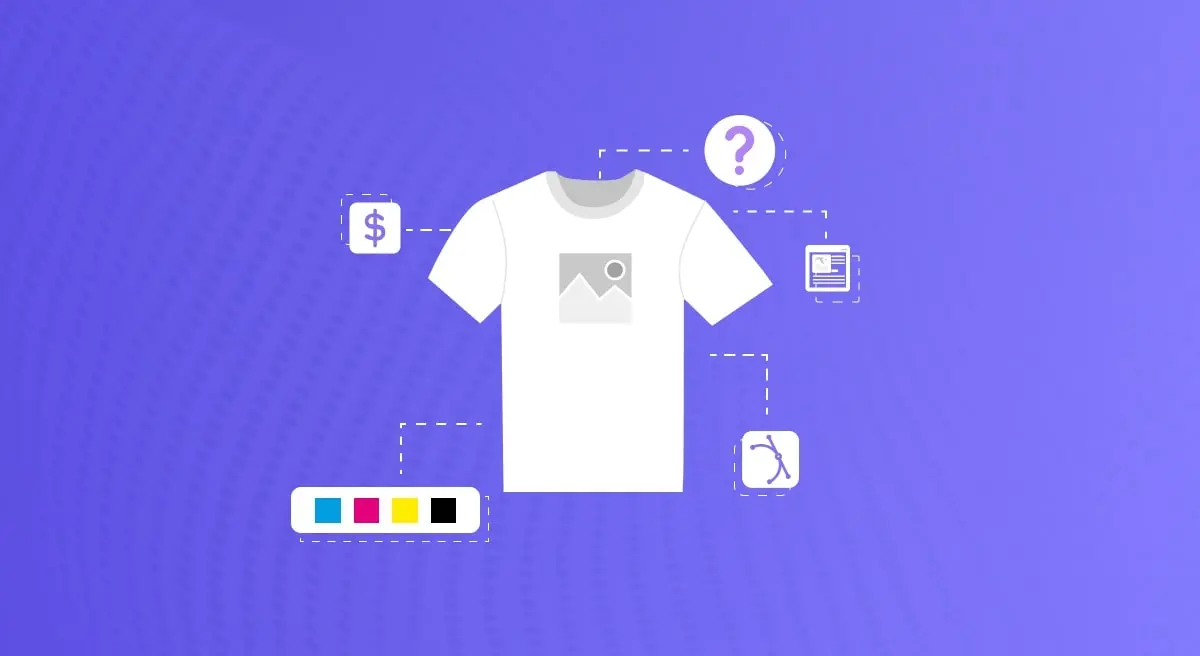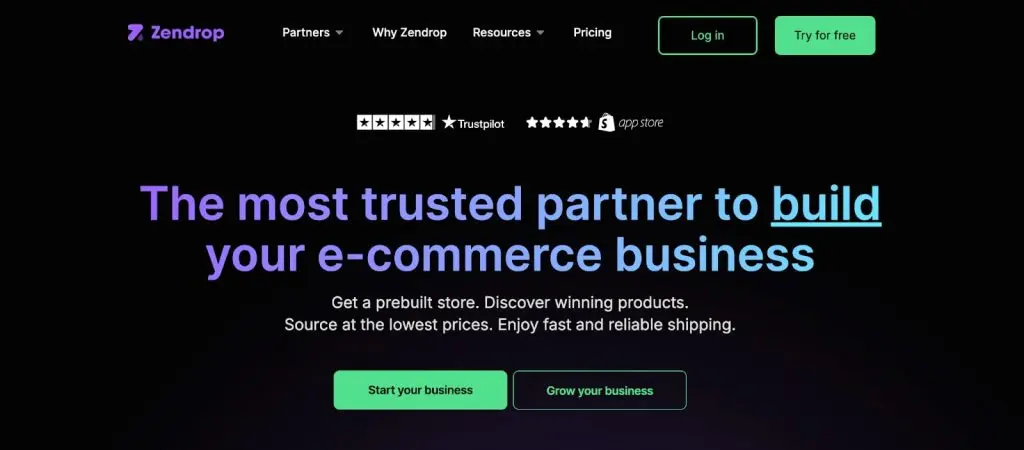
Print-on-demand (POD) is an e-commerce model that’s gaining popularity because of the convenience it offers. It involves creating custom designs and outsourcing the manufacturing to a third party.
Whenever someone orders the product, the manufacturer handles the printing and shipment. You’ll pay the manufacturer for its service and keep the rest as profit.
This guide will dive deeper into how print-on-demand works and how to leverage it to create a successful online business.
Print-on-demand (POD) is a business model in which you design products such as clothing and phone accessories and outsource the manufacturing to a trusted third party. When a customer orders an item, the third party makes and ships it to them. After paying this third party, the remainder is your gross profit.
Design, manufacturing, and shipping are the key aspects of understanding what print-on-demand is about. You’ll focus on the first aspect, design, and outsource the other two to a trusted print-on-demand supplier like Zendrop.

How does print-on-demand work? An illustration
Below is a step-by-step explanation of the print-on-demand business model.
Choosing the right supplier is crucial to building a successful print-on-demand business. You need a high-quality partner like Zendrop, which offers a wide selection of products and industry-leading shipping times.
Skilled artists can monetize their designs via the print-on-demand model. Stunning designs make t-shirts, mugs, phone pouches, and other items sell well.
Hence, artists can focus on designs and outsource the manufacturing to print-on-demand suppliers. They can make significant profits without experiencing inventory and manufacturing headaches.
General entrepreneurs can leverage print-on-demand to build a successful e-commerce business. As an entrepreneur, you’ll focus on designing and promoting your products to the right audience. You’ll sell products at significant markups from the print-on-demand company’s prices.
When people order your products, the print-on-demand company fulfills their orders, and you can make sizable profits because of your price markups. The key is promoting products to the right audience and having a unique value proposition.
Established brands can also benefit from the print-on-demand model. They can use it to quickly expand their product lines without investing in new supply chains.
Suppose a prominent clothing brand observes a new trending T-shirt. The brand can create a similar design and outsource the manufacturing to a print-on-demand company. This model allows the brand to quickly react to changing customer demand without revamping its supply chain.

Zendrop is the ultimate partner for print-on-demand businesses. Our platform helps you set up a successful print-on-demand business from the ground up. You can get a prebuilt store or use our AI-assisted storebuilder to create one via text prompts.
After creating your store, you can browse Zendrop’s expansive print-on-demand product selection. Our managed supply chain links you with the best print-on-demand manufacturers. Hence, expect high-quality products and industry-leading shipping at the lowest possible prices.
Zendrop is your everything app for running a robust print-on-demand operation. Our platform is integrated with Shopify, letting you import products and mockups at the click of a button.

Printful has a diverse product catalog and integrates with the most popular e-commerce platforms. Its robust shipping network enables quick product delivery regardless of your customer’s location.
Prinful's user-friendly interface makes setting up a print-on-demand business easy. It provides mockup generators to help customers visualize your products. You can even add your branding to the unboxing experience. Popular products on this platform include hoodies, mugs, phone cases, and tote bags.

Printify is a popular print-on-demand service with a diverse product selection. It has a global network of manufacturing partners to enable speedy delivery.
When a customer orders an item, fulfillment is handled by the manufacturing center closest to them. This distributed system ensures quick delivery and customer satisfaction.
Printify has reasonable prices, enabling you to sell items at competitive markups and make a profit. This platform is user-friendly and integrated with popular e-commerce platforms like Shopify, WooCommerce, and BigCommerce.

Gooten fulfills orders via a global network of partners. It offers products of varying qualities, giving you more flexibility over pricing and branding. You can choose precise product printing techniques and your desired shipping times.
This print-on-demand provider offers an intuitive editor for creating visually appealing products. It is integrated with popular e-commerce platforms, including Shopify, WooCommerce, TikTok Shop, BigCommerce, and Etsy.

Lulu is a unique print-on-demand company that specializes in custom book printing. It’s an ideal partner for designing custom notebooks, calendars, jotters, yearbooks, and photo books. Lulu integrates with popular e-commerce platforms like Shopify, Wix, and WooCommerce.
You can extensively customize products on Lulu, choosing the book’s length, binding type, template, page count, and other characteristics. This print-on-demand company offers affordable prices, making it easier to add markups and earn profits.
A successful print-on-demand business starts with choosing the right fulfillment partner. This partner can make or break your business, so choose them thoughtfully.
Consider the print-on-demand partner’s product selection, fulfillment costs, and shipping times. A vast product selection enables you to build a robust e-commerce business with many items. Shipping times are vital to customer satisfaction, as people hardly tolerate long delays.
Consider the product costs and whether customers can afford significant markups on these costs. Also, research the e-commerce platforms with which a print-on-demand provider is integrated.
Seamless integration makes it easier to list products on your store and send customers’ order details to the print-on-demand company.
Print-on-demand companies usually have integrations with popular e-commerce platforms. For example, Zendrop has direct integration with Shopify. This integration allows you to import print-on-demand products from Zendrop into your store at the click of a button.
When a customer orders an item, Zendrop automatically receives the order details and begins fulfillment. The Shopify integration lets entrepreneurs run their online stores without stress.
Check what print-on-demand providers offer integrations with your chosen e-commerce platform. After deciding, head to your e-commerce platform’s app store and download the print-on-demand provider’s app.
If possible, order samples of each product listed in your store. This step lets you evaluate product quality in person instead of relying primarily on third-party reviews and word of mouth.
We recognize that ordering samples might not be possible due to limited funds. However, if possible, it’s an effective way to evaluate the print-on-demand provider’s product quality and printing accuracy.
You can use mockup tools to showcase print-on-demand designs in your store. In this age of artificial intelligence (AI), tools like Mockey.ai can show your product being worn by a computer-generated human model.
Mockups make your store look professional and boost its credibility with customers. People, especially first-time shoppers, feel more comfortable ordering from professional-looking stores.
The e-commerce industry is fiercely competitive. Targeting a specific niche gives you the best chance of standing out and building a loyal customer base.
Your niche can be a single product line, such as T-shirts, phone accessories, or wristwatches. The thinner your niche, the better your chances of effectively promoting products and building a loyal following.
E-commerce stores selling a random product assortment tend to perform undesirably. It’s better to dominate a specific niche than to be a jack of all trades.
Learning about a print-on-demand business includes paying attention to printing techniques. Print-on-demand providers use different printing techniques of varying qualities. Consider which ones to choose based on your desired quality and price point.
The name of this printing technique is self-explanatory. Ink is printed directly onto fabric and left to soak in. When it dries, the fabric will be colorful and vibrant.

Example of a DTG-printed t-shirt
Source: Really Good Branding
Direct-to-garment printing is a popular method for producing decorative T-shirts, hoodies, and tote bags. This method is easy to scale, making it a top choice for fast-growing brands.
This method entails using high heat to transfer a design from a sublimation paper to a fabric. The combination of heat and pressure imprints the design on a material and makes it last long. Sublimation printing is perfect for all-over-print designs.

Example of sublimation printing
The drawback is that sublimation printing only works on polyester fabrics. It also doesn’t work for black or dark-colored materials because sublimation ink is too transparent to be printed on dark colors.
Some manufacturers work around the dark colors by printing the design on white vinyl and then attaching it to the dark-colored fabric. However, this workaround significantly increases production costs, and many print-on-demand companies are unwilling to use it.
This technique involves forcing ink through a mesh screen onto a fabric. The printed material is durable, making it suitable for high-quality products.

Screen printing example
Screen printing is affordable and easy to scale, making it suitable for businesses that sell mass-produced designs. If you plan to have a massive customer base, screen printing is an efficient way to make your products.
This technique involves printing a design onto a transfer film, which is then heat-pressed onto the desired fabric.
DTF printing is becoming more popular because it works for most types of fabrics, including colors that can be challenging for other techniques to decorate, such as red and yellow.
With DTF printing, you can create high-quality products with minimal preparation. The printed products are durable and cost-effective, boosting your chances of selling them at high markups.

DTF printing example
Choosing the right items to sell is a key aspect of learning what print-on-demand is. Some products are more popular than others in the print-on-demand niche, mainly T-shirts, eco-friendly products, and stationery. Let’s examine what makes them popular.
T-shirts are popular with print-on-demand companies because they have enormous demand and are easy to make. Almost everyone has T-shirts and keeps buying more. The better the design, the more attractive a t-shirt is to potential customers.
A T-shirt is a common starting point for entrepreneurs who want to launch print-on-demand businesses. Using different techniques, you can print stylish T-shirts and sell them at high markups.
Climate change awareness is as high as ever, so people are seeking eco-friendly products to reduce environmental pollution. This growing demand has made eco-friendly products a staple of print-on-demand businesses.
You can sell sustainable products like reusable water bottles and bags. Bamboo-derived home decor is another top-selling eco-friendly product. These products are easy to make, and customers can tolerate high prices for creative designs.
Many people prefer mugs and water bottles with creative designs. These designs help with personal expression and are aesthetically pleasing. If you’re a skilled designer, you can create the best visuals for drinkware items and make money when people buy them.
Notebooks, planners, calendars, envelopes, and other stationeries are also popular print-on-demand products. Many people love stationeries with vibrant colors, so you can make money by fulfilling their demands.
Zendrop offers a vast print-on-demand selection, including t-shirts, drinkware, stationery, and eco-friendly products. Our in-app tool streamlines the process of creating and listing products in your online store. Try our print-on-demand services today.
This guide has described what a print-on-demand business is about and what makes this model popular. We’ve also described what the best print-on-demand platform is, depending on your preferences.
The global print-on-demand market is expected to surpass $46 billion by 2031 from $6 billion currently. This statistic indicates rapid growth that you can leverage to build a successful print-on-demand business. Zendrop is your ideal partner for this business, so sign up and kickstart your venture today.
Yes, print-on-demand can be profitable if you put effort into designing unique, high-quality products.
It’s not a get-rich-quick business model. Rather, it demands effort to create stunning designs, curate an in-demand product selection, and promote products to the right audience. These efforts are a critical part of learning what print-on-demand is about.
You can price print-on-demand products by placing a fixed markup over the manufacturer’s price. For example, you can add a 50% markup to the cost of each item. After paying the print-on-demand manufacturer, this markup will cover your hosting and marketing costs and leave more profit for everyday expenses.
However, your pricing should be in line with those of your competitors. Over-pricing can drive customers away from your brand, so research your main competitors when setting prices.
Yes, print-on-demand is a good business model for new e-commerce entrepreneurs. It enables you to launch an e-commerce business without the risks of creating a supply chain from scratch. You’ll outsource supply chain bottlenecks to a third party and focus more on design and branding.
Yes, you can make significant passive income with print-on-demand. However, it takes considerable time and effort to set up the business initially for long-term success.
You’ll spend time creating enticing designs, choosing the right products, and promoting items to the right customers. If these efforts are successful, you can then relax and earn long-term revenue.
Print-on-demand and dropshipping are both good business models with respective pros and cons.
Dropshipping is best for people who want to launch e-commerce businesses quickly without customizing their products. In contrast, print-on-demand is perfect for people who want to customize their product lines extensively. The better choice depends on your personal business needs.
Yes, you can technically start a print-on-demand business for free. Many e-commerce platforms offer free trials you can leverage to build a store. Then, you can integrate a print-on-demand app for free.
After your first badge of sales, you can use the profit to pay recurring hosting and marketing expenses.
